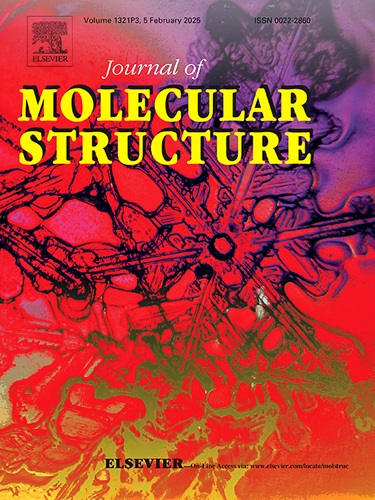Synthesis, characterization and computational insight into the reactivity of chromium isoporphyrins
IF 4
2区 化学
Q2 CHEMISTRY, PHYSICAL
引用次数: 0
Abstract
The synthesis, characterization and theoretical studies of three new chromium isoporphyrins are reported because a comprehensive study on chromium isoporphyrin is not known in the literature. On treatment with ammonium ceric nitrate as an oxidizing agent in a methanol medium chromium porphyrins easily form compounds which have strong absorbance at lower energy region (800 to 900 nm) which is the unique indication of isoporphyrin formation. Based on the standard spectroscopic (UV–Visible, Mass, PXRD and IR spectroscopy) analysis used for isoporphyrin characterization it is reasonable to conclude that the synthesized compounds are most probably methoxy chromium isoporphyrins, and accordingly named as chloro[5-(methoxy)-5,10,15,20-tetrakis-5,21H porphinato]chromium(III) nitrate,(1b), chloro[5-(methoxy)-5,10,15,20-tetrakis(4-methyl)- 5,21H-porphinato]chromium(III) nitrate,(2b), chloro[5-(methoxy)-5,10,15,20-tetrakis(4- methoxy)-5,21H-porphinato]chromium(III) nitrate, (3b). The parent compounds for the isoporphyrins are respectively [CrIIITPPCl] (1a), [CrIII(4-MeTPP)Cl](2a) and [CrIII(4- OMeTPP)Cl](3a). We have also performed theoretical studies at DFT levels, such as geometry optimization, energy calculation, simulation of UV–Vis spectra, NBO, and global reactivity indices to understand the distinctive properties of the chromium isoporphyrins for the first time. The theoretical UV-visible spectra and HOMO-LUMO energy gap supported experimental results. Moreover, Rietveld refinement showed that the experimental PXRD plots closely match the theoretical plots supporting that the experimental structures are similar to the theoretically optimized structures. Chromium isoporphyrins are found to have a lower HOMO-LUMO energy gap than their parent porphyrins, which accounts for their ease of reduction and the appearance of UV–Vis spectra at lower energy regions. Furthermore, we investigated the antioxidant properties of chromium methoxy isoporphyrins and compared them to their parent porphyrins and observed that complex 3b (77 %) has the highest antioxidant activity.

求助全文
约1分钟内获得全文
求助全文
来源期刊

Journal of Molecular Structure
化学-物理化学
CiteScore
7.10
自引率
15.80%
发文量
2384
审稿时长
45 days
期刊介绍:
The Journal of Molecular Structure is dedicated to the publication of full-length articles and review papers, providing important new structural information on all types of chemical species including:
• Stable and unstable molecules in all types of environments (vapour, molecular beam, liquid, solution, liquid crystal, solid state, matrix-isolated, surface-absorbed etc.)
• Chemical intermediates
• Molecules in excited states
• Biological molecules
• Polymers.
The methods used may include any combination of spectroscopic and non-spectroscopic techniques, for example:
• Infrared spectroscopy (mid, far, near)
• Raman spectroscopy and non-linear Raman methods (CARS, etc.)
• Electronic absorption spectroscopy
• Optical rotatory dispersion and circular dichroism
• Fluorescence and phosphorescence techniques
• Electron spectroscopies (PES, XPS), EXAFS, etc.
• Microwave spectroscopy
• Electron diffraction
• NMR and ESR spectroscopies
• Mössbauer spectroscopy
• X-ray crystallography
• Charge Density Analyses
• Computational Studies (supplementing experimental methods)
We encourage publications combining theoretical and experimental approaches. The structural insights gained by the studies should be correlated with the properties, activity and/ or reactivity of the molecule under investigation and the relevance of this molecule and its implications should be discussed.
 求助内容:
求助内容: 应助结果提醒方式:
应助结果提醒方式:


